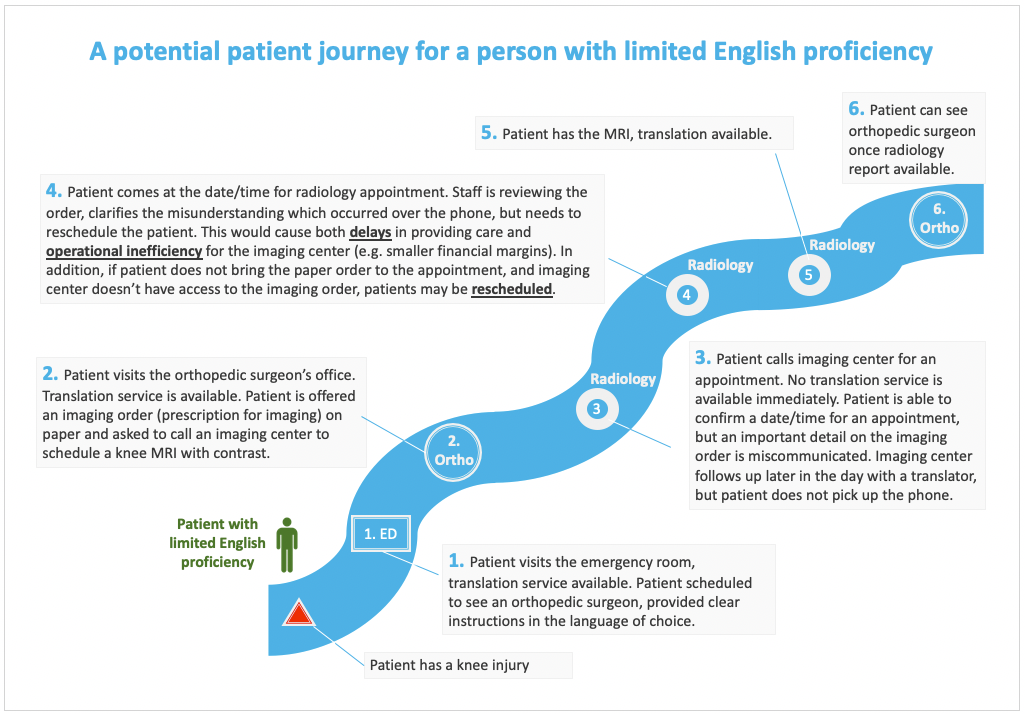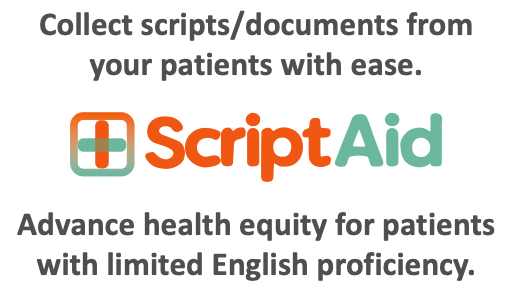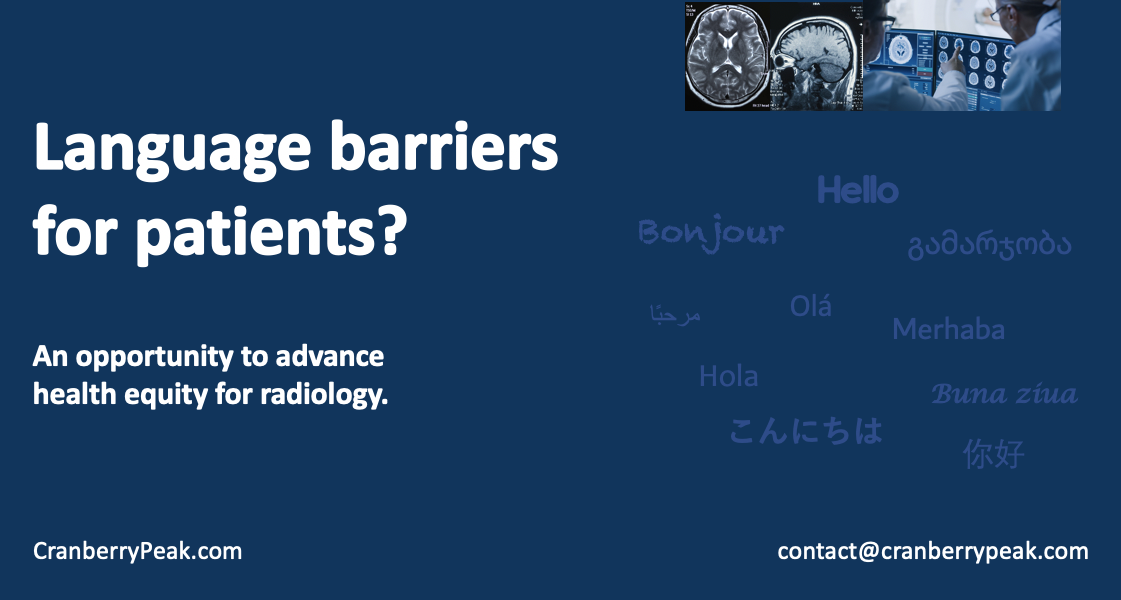Limited English proficiency patients
According to the Agency for Healthcare Research and Quality, nearly 25 million people in the United States (8.6%) are defined as limited English proficient (LEP), meaning that they speak English less than "very well." Therefore, at least 8.6% of the U.S. population is at risk for adverse events because of barriers associated with their language ability [1].
When in need of health care, often times this may be a challenge both for this patient population (LEP) and for their healthcare providers. While during their healthcare appointment, these patients may benefit from certified medical translators, before their appointment, language barriers may pose significant challenges to seeking prompt healthcare.
A hypothetical patient journey in radiology
We will focus on a possible scenario in radiology and see how this scenario may be improved for patients, providers and health equity in general.

Let's consider a patient with limited English proficiency who has a knee injury.
1.ER visit
The patient visits the emergency department (ED) to seek care. At the ED, as translation services are available, the patient - care team communication is seamless. The care team at ED is suggesting the patient see an orthopedic surgeon to determine the course of action. The patient is assisted with scheduling the appointment with the orthopedic surgeon's office, and provided clear instructions regarding the next appointment.
2. Orthopedic surgeon visit
Patient then visits the orthopedic surgeon’s office at the appointment time/date. Translation service is available, so again, the conversation is facilitated in real time. The orthopedic surgeon is referring the patient to an imaging study, issuing an imaging order for a knee MRI. The prescription is provided on paper to the patient (often called script). Many of these scripts are electronically shared by the referring physician with the radiology center. However, paper or fax referrals may account for as many as 30-40% for an outpatient radiology practice.
3. Scheduling the MRI
Patient then calls an imaging center to schedule the MRI appointment. No translation service is available immediately on the phone. Patient however is able to confirm a date/time for an appointment, but important details available on the imaging order are miscommunicated. Imaging center follows up later in the day with a translator, but patient does not pick up the phone.
In virtually all instances before an imaging appointment, the radiology practice staff would talk to the patients over the phone. One of the goals is to collect information available on the referral form, especially for referrals on paper. In these instances, the patients are also required to bring their prescription along at the time of their appointment. Any critical misunderstanding occurring over the phone, especially when discussing complex clinical terminology, would result in delaying of care.
4. MRI appointment
Patient comes at the date/time for imaging appointment. Staff is reviewing the order, clarifies the misunderstanding which occurred over the phone, but needs to reschedule the patient. This would cause both delays in providing care for the patient and operational inefficiency for the imaging center (e.g. smaller financial margins). Moreover, if patient does not bring the paper order to the appointment, and imaging center doesn’t have access to the imaging order, patients may be rescheduled. Occasionally, the patient is not returning, and has a missed or delayed opportunity of care. In particular, patients with limited English proficiency or other vulnerable patient population groups, such as underrepresented minority patients are at risk.
In addition to potential delays in care, this may and often does impact the financial health of the healthcare organizations providing care to these patient populations. These organizations are often under severe financial pressure, sometimes at risk of insolvency, which may result in no healthcare available in areas with vulnerable patients.
5. MRI scanning
When all required information is available, the patient can get the MRI; translation services may be available to facilitate the patient encounter. Once MRI scan available, the radiologist will review it and generate a radiology report. The radiology report is then shared with the referring provider, in this case the orthopedic surgeon.
6. Visit orthopedic surgeon
The patient will receive a call from the orthopedic surgeon's office to schedule the follow up appointment to review the radiology report and plan the next steps for this episode of care. In this step, there may be challenges with language barriers; translation service may be used. Yet, at this point there wouldn't normally be a need for any additional information from the patient, just to confirm the date/time of the appointment. Often however, there may be again delays of care, with possible no follow ups from the patient or challenges to get in touch with the patient.
Current healthcare environment and solutions for patients with limited English
According to a Kaufman Hall analysis [2], the healthcare industry is facing currently several unprecedented challenges. For instance, (1) hospitals are experiencing some of the worst margins of the pandemic. Seven months into 2022, organizations accrued enormous losses; (2) margins are dramatically decreasing, with lower outpatient activity and revenue, and labor expenses increasing; (3) labor expenses increased, with labor still in high demand, and prices rising accordingly; (4) outpatient activity dropped, as the pent-up demand for outpatient procedures following the Omicron surge lessened.
Overall, most healthcare organizations are currently facing high financial pressure and are focusing on managing costs. This challenge is only compounded by an acute shortage of staff. In the hypothetical case scenario discussed above, there are still gaps in communication with patients that can results in sub-optimal care for patients with limited English proficient.
As a vast majority of healthcare organizations rely on certified medical translators to provide clear real-time communication with patients, given the above financial and staff strain for healthcare organizations, some of them might not be able to provide promptly the translation services for a diverse group of patients. In the scenario presented above, even with organizations with translation services available promptly, patients with limited English proficiency may have delays or sub-optimal care.
Software technology has the potential to address some of the communication challenges, and will likely gain traction in the years ahead, given the magnitude of these challenges.
Our solution, ScriptAid
We will briefly discuss a practical solution, ScriptAid, a software service that our company, Cranberry Peak has introduced and validated on the market. In short, ScriptAid allows the radiology practice to send a request for information to the patient, in more than 100 languages, either while on the call with the patient or off the phone. The patient then follows the clear ScriptAid instruction in the language of choice, and submits the information to the radiology practice. In a 6-month study, ~5% of patients used ScriptAid in a language other than English (recall that 8.6 percent of the US population has limited English proficiency). In the same study, overall, 89% of patients accessing ScriptAid, successfully uploaded their script, 57% of patients uploaded their script in <2 min with ScriptAid and 27% of patients uploaded their script in less than 1 min.
With a very intuitive user interface, ScriptAid is designed to be easy to use by patients, even those who are not experts in technology.
Finally, for outpatient radiology practices, ScriptAid is designed:
(1) to fit seamlessly in the current workflow for imaging staff.
(2) with a light footprint - as cloud based software as a service, the radiology practices do not need to purchase any additional hardware, the staff has access to ScriptAid (even when working from home) with just an internet browser (e.g. Chrome).
(3) with a quick implementation process - it could take one day effort to go live for a new practice with no software integration needed.
(4) with 1 hour training required for the staff in the implementation phase.
Cranberry Peak benefited from the Microsoft for Startups Program, and is currently leveraging Microsoft Azure technology to develop and to provide a state of the art software, ScriptAid.
ScriptAid can address effectively one at least one of the gaps that many current radiology practices may have in communicating with their patients, while supporting patients with limited English proficiency and advancing health equity.

More details may be found at CranberryPeak.com or by email at [email protected]
--
Dr. Neculai Archip is the Founder and CEO of Cranberry Peak, a digital health company based in Cambridge, MA, focused on innovative technology solutions for the radiology industry. An entrepreneurial executive with strong record of success in the tech and healthcare industries with Siemens Healthcare, Siemens Venture Capital, Microsoft and several start-ups. Dr. Archip served as an Assistant Professor of Radiology at Harvard Medical School, and held a research appointment at Brigham and Women's Hospital in Boston, MA. Dr. Archip holds a BSc (Romania) and PhD (Switzerland) in Computer Science, in addition to an MBA from Cornell University. Neculai was born in Romania, and has called the United States home for many years. He also lived in several countries, traveled to several dozens of countries, and as a consequence, is fluent in several languages and passionate about languages as a way to connect with people.
[1] Improving Patient Safety Systems for Patients With Limited English Proficiency. Agency for Healthcare Research and Quality. Link.
[2] National Hospital Flash Report. Kaufman Hall. August 2022. Link
